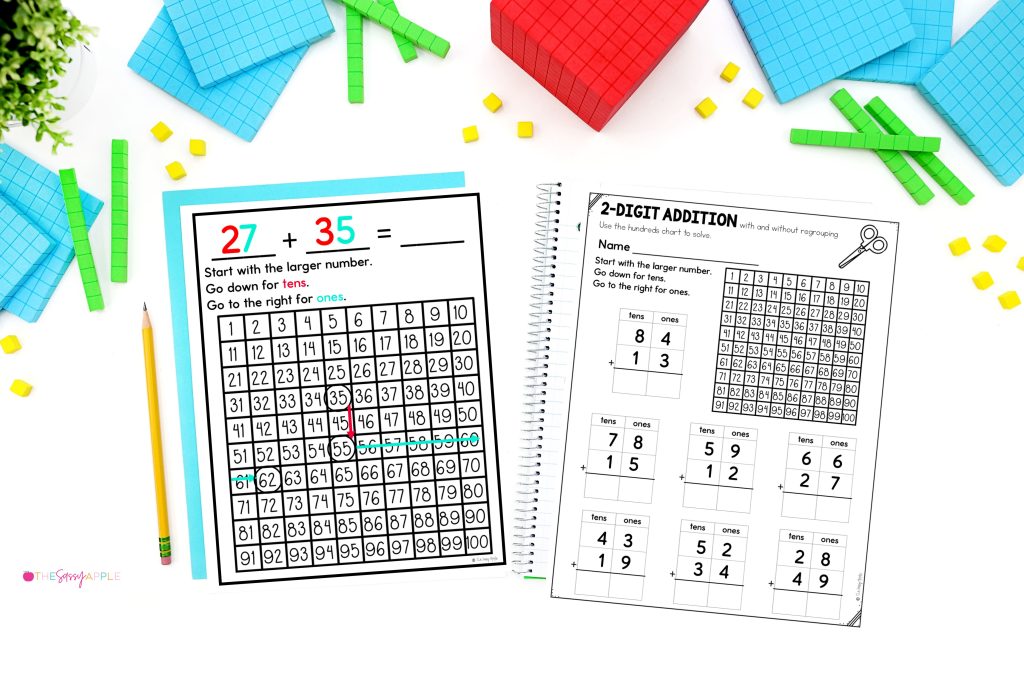If I’m being completely honest, teaching how to carry over or regroup wasn’t exactly my favorite math lesson. When I started teaching 2nd grade, the math curriculum we used taught 2-digit addition with regrouping before place value.
Seriously? Who does that?
Once we rearranged the math curriculum chapters (because obviously, we had to), teaching how to add with regrouping wasn’t quite as soul-crushing. So, let’s talk about how to get kids to understand it without you wanting to bang your head against the whiteboard.
Start with Place Value
It all starts with number sense and place value. If kids don’t understand that numbers have different values based on where they are, regrouping will feel like absolute wizardry.
Use place value charts, base-ten blocks, and literally anything hands-on to show them what’s happening when we regroup. You need them to see that ten ones magically become one ten before they start carrying numbers all over the place like they’re delivering pizzas.

One of my favorite games to sneak in some number sense practice is Trash Can Math. It’s simple, fun, and low-prep. Plus, kids love anything that involves throwing stuff (controlled chaos, of course). [Learn how to play here.]
Relevant and Hands-On
Before teaching any strategies, I present students with real-world examples.
Strategies to Keep It Real:
- Act it out: Have students literally carry a “ten” over to the next column using blocks or big visuals. Make it dramatic.
- Let them use manipulatives FOREVER: Seriously, don’t snatch those base-ten blocks away too soon. They need them!
- Make it visual: Draw it, model it, have them build it. The more ways they see it, the better.
Repetition and practice are essential for learning 2-digit addition with regrouping. However, the quality of the exposure is just as important as the quantity. Meaningful, engaging, and varied experiences tend to be more effective in supporting learning.
Break down the Strategies
Regrouping can feel overwhelming, so breaking it into bite-sized, easy-to-follow steps is key.
My Go-To Strategies for Addition with Regrouping:
- Standard algorithm (your classic “carry the one”)
- Open number line (great for visualizing what’s happening)
- Hundreds Chart (down for the tens and to the right for the ones)
- Compensation (adjusting numbers to make them easier to add)
- Expanded form (breaking numbers apart to see what’s really happening)
- Base-10 blocks (because manipulatives are magic)
- Decomposing numbers (a fancy way to say “breaking numbers into smaller parts”)

Work Together
Math doesn’t have to be a lonely struggle! Getting kids to work together can be a game-changer.
Collaborative Activities:
Math Games: The more you can sneak in games, the better. Kids learn so much when they think they’re just playing.
Word Problem Walk: Post different word problems around the room. Students solve each one with a partner before rotating. Keeps them moving and engaged!
2-Digit Addition Review & Practice
Repetition is key to mastering any skill. Create worksheets with a variety of addition problems that require regrouping and encourage students to practice regularly. Offer feedback and support as they work through the problems, and gradually increase the complexity of the exercises as their confidence grows.

Teaching 2nd graders how to add with regrouping doesn’t have to feel like pulling teeth. Start with place value, break it down step by step, use hands-on tools, and make it fun.
Before you know it, your students will be adding like pros, and you’ll get to enjoy that glorious moment when it finally clicks. (And maybe reward yourself with some chocolate—because you deserve it.)


